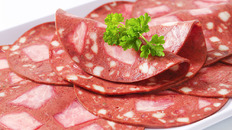Meats and Sausages
Pomerania Black Head Cheese (Salceson Czarny Pomorski)
| Meats | Metric | US |
|---|---|---|
| Snouts, dewlaps, pork head meat | 300 g | 0.66 lb |
| Jowls | 250 g | 0.55 lb |
| Skins, pork or veal leg meat | 100 g | 3.52 oz |
| Lungs, boiled beef, veal or lamb head meat, boiled bone meat, pork and beef trimmings,** skwarki * | 150 g | 5.29 oz |
| Blood | 200 g | 0.44 lb (200 ml) |
Ingredients per 1000g (1 kg) of meat
| Salt for curing | 12 g | 2 tsp |
| Cure 1 | 1.5 g | 1/3 tsp |
| Salt | 12 g | 2 tsp |
| Pepper | 1.0 g | 1/2 tsp |
| Marjoram | 1.0 g | 1/2 tsp |
| Garlic | 1.0 g | 1/2 clove |
Instructions
- For pink color cure meats. Cut the meats into one inch pieces, mix with salt (12 g) and cure 1. Pack tightly and leave for 48 hours in refrigerator. Meats not cured are rinsed only.
- Poach meats in a small amount of water:
- pork heads,snouts and jowls, lungs and pork class IV at 85°C (185°F) until soft.
- skins, heads and legs at 95°C (203°F) until soft.
- dewlaps at 85°C (185°F) until semi-soft.
- After poaching remove gristle from lungs and meat from heads and legs. Spread apart on a flat surface to cool.
- Cut boiled snouts and jowls and poached dewlaps into 15 mm (5/8”) cubes. Except skwarki * grind all meats through 3 mm plate.
- Mix ground meat with spices and blood.
- Stuffing. Pork middles, bladders or stomachs, beef, veal and lamb bungs, 60-100 mm synthetic casings. Stuff casings loosely and sew the ends with twine.
- Poach head cheeses at 82°C (180°F) for 90-120 min (depending on size) until the internal temperature of the meat reaches 68-70°C (154-158°F). Remove air with a needle from pieces that swim up to the surface.
- Spread head cheeses on a flat surface at 2-6°C (35-43°F) and let the steam out. Then flatten them with weight and cool them to below 6°C (43°F). If there is no proper cooler available, cool them down to less than 12°C (53°).
- After cooling clean head cheeses of any fat and aspic that accumulated on the surface, even them out and cut off excess twine.
Notes
* Skwarki are light brown fried pork cubes that look like fried bacon bits. Dice pork back fat or fat pork trimmings into ¼ cubes and fry in pan using slow heat until becoming light brown. Skwarki is the byproduct of making lard by fat rendering. Fatback is the preferred choice and skwarki with lard have been used as butter in Europe for centuries.
**Meat trimmings of all kind: hearts, kidneys. pork and head meat, lungs, veal casings, beef tripe, udders, spleen, low grade pork and beef trimmings. Some of these meats will be hard to obtain in metropolitan areas, however, you can substitute them with meats which are rich in connective tissue such as pork legs or jowls. They contain collagen which is needed to produce the natural gelatin.
Lamb meat total must not exceed 10 kg. In case that meats described in 3-5 are partly salted this fact must be taken under consideration when adding salt during production. Skwarki (* see notes) must not exceed 5 kg.
Final shape will depend on individual characteristics of a casing used. Approximated sizes (length x width x height in centimeters): pork- middles (25 x 12 x 7), bladders (2 x 20 x 7), stomachs (25 x 15 x 7) veal or lamb: bungs (18-25) x 12 x 7 beef : bungs (40-45) x (8-14) x (5-9)














